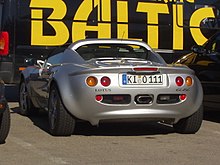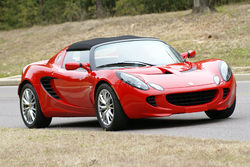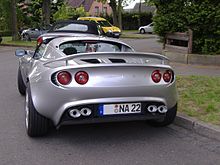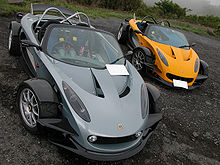Lotus Elise
| Lotus Elise | |
|---|---|
| Production period: | since 1996 |
| Class : | Sports car |
| Body versions : | Roadster |
| Previous model: | Lotus Elan |
The Lotus Elise is a sports car from Lotus Cars .
history
The car was shown for the first time in 1995 at the International Motor Show in Frankfurt am Main . The concept was unusual: small dimensions, a small mid-engine and the lack of any comfort combined with high-quality lightweight construction resulted in a sports car with excellent performance at half the price of a Porsche 911 . The Elise is less in the tradition of classic roadsters , but rather follows the motto of the company founder Colin Chapman "First take simplicity, then add lightness".
The innovative core element of the Elise is its chassis , which was designed by Lotus employee Richard Rackham, developed for series production at Lotus and produced by the Danish supplier Hydro Aluminum . It consists of an aluminum alloy , weighs only 65 kg, and the individual sheets and profiles are not joined by welding , but by gluing and riveting , whereby the rivets keep the peeling stress away from the glued areas and thus tear off the viscous ones Prevent splices. The body of the Elise is made of glass fiber reinforced plastic . A closed variant derived from racing is offered as the Exige .
Lotus used numerous standard components from other manufacturers for the equipment. Steering column switches, window cranks and inner door handles are also used by Vauxhall / Opel, the switches for ancillary functions and the heating control Peugeot. The instrument panel comes from the motorsport supplier Stack.
Elise was named after Elisa, the granddaughter of Romano Artioli , the chairman of the board at the time of the first introduction and at that time owner of Lotus.
The market success of the vehicle far exceeded the manufacturer's expectations and resulted in delivery times of well over a year.
In 2012, according to the Federal Motor Transport Authority, 41 new Lotus Elise vehicles were registered in Germany, 12 of them by commercial owners.
Series 1 (1996-2000)
| Elise S1 | |
|---|---|
| Production period: | 1996-2000 |
| Body versions : | Roadster |
| Engines: |
Petrol engines : 1.8 liters (88–162 kW) |
| Length: | 3726 mm |
| Width: | 1701 mm |
| Height: | 1201 mm |
| Wheelbase : | 2300 mm |
| Empty weight : | 723-770 kg |
The Elise S1 , the first Elise series sold in 1996, was a best seller. It was supplied with the popular 1.8-liter engine from the MG Rover Group's K-series . In the standard Elise 111 version , the four-cylinder has an output of 90 kW (122 hp). To save even more weight, these vehicles were initially equipped with brake discs made from an aluminum-ceramic material mix, which were very expensive to manufacture but also very light.
From 1998 the Elise 111S was available with an engine equipped with variable valve control and an output of 107 kW (145 hp). These vehicles were always equipped with brake discs made of gray cast iron , as the lightweight brakes of the standard model were not considered appropriate for the performance. Shortly thereafter, these brakes became standard equipment on all versions.
Due to the unexpectedly good sales success of the first series, Lotus had a new negotiating position with suppliers and was able to implement a number of model-specific developments for the second series. The second series, for example, had shock absorbers whose tuning was specially adapted for the Elise, while the first series still had to make do with an existing standard design. Yokohama also produced special tires with a rubber compound tailored to the Elise.
Lotus also offered some special models with engines of higher power. The following special editions were made between 1998 and the end of the S1 in 2000:
- Elise Sport 135 with 100 kW (136 PS)
- Elise Sport 160 with 116 kW (158 PS)
- Elise Sport 190 with 141 kW (192 PS)
These models have also been modified on the chassis and body in order to do justice to the higher performance.
Number of pieces built:
- 1995/1996 16 pre-production
- 1996 425 (all 111s)
- 1997 2,155 (all 111s)
- 1998 3,032 (2,982 111, 50 135)
- 1999 3,164 (of which 1,973 111s, 1,148 111S, 35 135s and 8 motorsport)
- 2000 1,775 (of which 1,111 111, 335 111S, 28 motorsport and 301 160)
- 2001 approx. 10 (all 160s)
Total quantities:
- 8,741 Elise
- 1,483 Elise 111S
- 36 Motorsport Elisen
- 311 Elise 160 / S160
Special models (49er, JPS, Millenium, 50th etc.) are included in the quantities of the types.
Series 2 (2000-2010)
| Elise S2 | |
|---|---|
| Production period: | 2000-2010 |
| Body versions : | Roadster |
| Engines: |
Petrol engines : 1.6–1.8 liters (90–163 kW) |
| Length: | 3785 mm |
| Width: | 1719 mm |
| Height: | 1143 mm |
| Wheelbase : | 2300 mm |
| Empty weight : | 740-950 kg |
The second generation of the Elise Series II came on the market in 2000 with a revised body and chassis. It had a Rover engine with 90 kW (122 hp). In 2002, a second model of the Elise, the Elise 111S, with a 156 hp Rover engine was launched.
From 2004 the Elise 111R variant with a 1.8-liter engine was offered by Toyota ; with its direct injection it developed 141 kW (192 hp). After the bankruptcy, Rover could no longer deliver Euro 3 engines. Therefore, for the 2006 model year, the company switched from Rover to Toyota engines.
Model year 2006
For the 2006 model year, the Elise 111 and Elise 111S versions with the Rover engines were completely discontinued. Driven by Toyota engines Version Elise 111R was further built the same, but in Elise R renamed.
The new basic model from 2006 was the Elise S with a 100 kW (136 hp) Toyota engine.
All Toyota models received an anti-lock braking system (ABS) as standard . To do this, Lotus had to slightly revise the front of the Elise to create the necessary space. The tailpipe of the exhaust system has also been moved down on all Toyota models.
Lotus Elise SC (2008) / model year 2008
In 2008 the top model of the Elise Series II came onto the market and was named Elise SC (English " s uper c harged" = charged). The same Toyota engine is used as was previously used in the Elise R. With supercharging, however, an output of 163 kW (222 hp) and smooth acceleration at lower speeds was achieved. With an empty weight of 903 kg, this results in a power-to- weight ratio of 4.1 kg / PS. This Elise only needs 4.6 seconds to accelerate from 0 to 100 km / h. The Elise SC was the only model to have a rear wing. In addition, the Elise SC received forged aluminum wheels and a different tank as standard. The new price for the Elise SC began in Germany at around 50,000 euros.
The 2008 model year brought further changes to the interior of the vehicles for all models. The dashboard with airbag previously used in the USA was now used as standard in Europe for the driver and front passenger. The headlights and taillights of the vehicles have also been revised.
The four optional equipment packages for the Elise have been combined into the two versions "Touring Package" and "Sports Package". There are differences between the USA models and the European models, including in the touring package. In the USA, for example, the additional headlights of the European Touring package were not offered.
Lotus Elise Club Racer (2009)
Based on the Elise S, Lotus offered the "Elise Club Racer" for the 2010 model year with the tried and tested 1.8 liter engine and 100 kW (136 hp). The special model was available in four color combinations that were already available from Lotus in the 1960s: Elite Yellow, Carbon Gray, Sky Blue and Old English White. At the same time, the model was given a special Club Racer interior, which can later also be found in Series 3 from model year 2010. The special model is a lighter and cheaper version of the Elise with anthracite-colored anodized, six-spoke aluminum wheels. In Germany the vehicle cost 33,125 euros in 2009. A total of 137 pieces of this special model were built.
Special models from 2000 to 2010
In the years 2000 to 2010, various special models of the Elise Series II or limited editions of the Elise were produced. Each limited edition has its own story, which is supposed to be a reminder of earlier Lotus racing cars, racing successes or the company anniversary, for example.
- Elise Sport 190 from 2002
- Elise Type 25 from 2002
- Elise Type 49 from 2002 (Gold Leaf)
- Elise Type 72 from 2002 (John Player Special)
- Elise Type 23 from 2003
- Elise Type 99T from 2003
- Elise 135R from 2003
- Elise Sport 111 2003-2004
- Elise Sports Racer 2005
- Elise S 60th Anniversary from 2008
- Elise Type 72D from 2008 (John Player Special)
- Elise S Club Racer from 2009
Lotus Elise S 60th Anniversary (2008)
For the company's 60th anniversary in 2007, Lotus produced a special version of the Elise S for the 2008 model year. This differs from the normal Elise S of the current model year in numerous details. These include the special color Burnt Orange , the standard hardtop, a painted rear diffuser and black painted wheels, the leather trim with orange stitching, the center console painted in the body color and the exterior parts also painted in the body color. The orange-colored brake calipers are another feature of the special model, as is a badge in the interior, on which the vehicle number and the total number of units of the special model are noted. Country-specific stickers are also available.
The total of 50 vehicles will be distributed to the individual countries in the following numbers:
- Germany: 15
- Switzerland: 10
- France: 5
- Belgium: 5
- Italy: 6
- rest of Europe: 9
- Great Britain, the home of Lotus, did not account for a single copy.
To celebrate the 60th anniversary and the renewed sales increase of 9%, the vehicle was sold at a price advantage of 10%. The only extras available were air conditioning and Lotus traction control. The sales prices include local taxes and delivery costs:
- Germany: 39,995 euros
- Switzerland: 58,600 CHF
- France: 40,200 euros
- Italy: 40,800 euros
- Belgium: 40,600 euros
- Netherlands: 53,600 euros
Prototypes
Lotus Eco Elise (2008)
The Eco Elise is a concept vehicle that does not concern environmental protection in terms of the CO 2 emissions of the engine, but rather through the materials used in vehicle construction. Environmentally friendly materials such as hemp , wool , sisal , novel water-based paints and the like were used for the body panels, showing new affordable environmentally friendly techniques. The vehicle also has a gearshift recommendation display. The car is based on a 111S, but weighs 32 kg less. The lightweight wheels alone weigh 15.8 kg less than the standard Elise wheels, which are already light. Further weight is saved by a lightweight audio system from Alpine , which weighs 1.5 kg less than a normal system thanks to the use of lighter loudspeakers and a lighter control panel.
Series 3 (since 03/2010)
| Elise S3 | |
|---|---|
|
Lotus Elise (since 2010) |
|
| Production period: | since 2010 |
| Body versions : | Roadster |
| Engines: |
Petrol engines : 1.6–1.8 liters (100–186 kW) |
| Length: | 3824 mm |
| Width: | 1719 mm |
| Height: | 1117 mm |
| Wheelbase : | 2300 mm |
| Empty weight : | 830-931 kg |
The Series 3 of the Elise has been on the market since March 2010. The model is sometimes also referred to as a facelift version. The body has been redesigned, including light-emitting diode daytime running lights as standard . From 2010 the basic model received a new engine with a displacement of just 1.6 liters, but the same output of 100 kW (136 hp). He continued to come from Toyota.
The body was revised in various areas. The front of the body was changed, the front indicators were designed to be less noticeable, there were new headlights with LED daytime running lights, the plastic louvres in the ventilation openings were replaced with simpler grilles, the decorative louvres on the rear of the vehicle were omitted, the bonnet was changed and the diffuser at the rear was revised .
For the 2011 model year, only two models with the same engine of 1.6 l with 100 kW (136 hp) were offered in Germany: The Elise and the Elise CR (Club Racer), which continues the concept of the Club Racer from 2009. In addition, both 2010 models are available as "Black Edition" or "White Edition". In Great Britain, a version of the Elise S3 with 142 kW (192 PS) and 162 kW (220 PS) will continue to be offered for the time being, but this would no longer be registered in Germany due to a change in the law on emissions and will therefore no longer be sold in Germany from January 2011 becomes. In the USA in 2011, a change in the law in the area of airbags leads to the complete cessation of sales of the Lotus Elise. Sales with the Lotus Elise Final Edition will end there.
With a further facelift, the production of the 142 kW version (192 hp) was discontinued and in 2012 a successor model for the Elise SC came onto the market in Germany, again called the Elise S. The name Elise S was no longer the cheapest version of the Elise, but the 162 kW (220 PS) successor to the Elise SC. The car received a new engine from Toyota. Three models were offered in 2012: the Elise 1.6 with 1.6 l displacement (100 kW / 136 PS), the sports model Elise S with supercharger (162 kW / 220 PS) and the cheapest weight-reduced model Elise CR (Club Racer) with the Engine of the Elise 1.6 (100 kW / 136 PS).
Technical specifications
| Sports | Sport 220 | Cup 250 | Cup 260 | |
|---|---|---|---|---|
| Construction period | 03 / 2010-08 / 2018 | since 11/2015 | since 06/2016 | 12/2017 |
| Engine characteristics | ||||
| Engine type | R4 petrol engine | R4 gasoline engine, supercharged | ||
| Displacement | 1598 cc | 1798 cc | ||
| Max. Power at min −1 | 100 kW (136 PS) / 6800 | 162 kW (220 PS) / 6800 | 181 kW (246 PS) / 7200 | 186 kW (253 PS) / 7200 |
| Max. Torque in min -1 | 160 Nm / 4400 | 250 Nm / 4600 | 250 Nm / 3500-5000 | 265 Nm / 5500 |
| Power transmission | ||||
| drive | Rear wheel drive | |||
| Gearbox, as standard | 6-speed manual transmission | |||
| Gearbox, optional | - | |||
| Readings | ||||
| Top speed | 204 km / h | 233 km / h | 248 km / h | 243 km / h |
| Acceleration, 0-100 km / h | 6.5 s | 4.6 s | 4.3 s | 4.2 s |
| Fuel consumption over 100 km (combined) | 6.3 l super | 7.5 l super | ||
| CO 2 emissions (combined) | 149 g / km | 173 g / km | 175 g / km | |
| Tank capacity | 40 l | |||
Lotus 340R (YOC 2000, 340 pcs.)
The lightest and most reduced model of the Elise debuted in 2000 with the 340R with 130 kW (177 hp). It has no roof, closed sides without doors, free-standing wheels and a shortened rear. Originally, the name 340R should refer to the ratio of nominal power and vehicle mass in HP / t. But since only 262 hp / t were achieved, the number was related to the planned number of units. Its weight is 635 kg. A British car magazine determined the standard slalom with a traffic cone spacing of 18 m, the highest speed ever achieved by a production vehicle of 78.4 km / h.
Offshoot
The Elise is the technical basis of a number of models from various brands:
- The Lotus Exige as a coupé version
- The Lotus 2-Eleven as a track-oriented sports model without doors and windshield
- The Opel Speedster and its sister models Vauxhall VX220 and Daewoo Speedster were developed and produced by Lotus on behalf of General Motors .
- The Lotus Europa S is designed to be less radical as a Gran Turismo .
- The Tesla Roadster is an electric car co-developed and produced by Lotus .
- The Dodge Circuit EV
- The Melkus RS2000 was presented at the IAA 2009.
- The Rinspeed sQuba is a submersible concept car / amphibious vehicle.
- The Aerocar 2000 is a flyable prototype from Aerocar Incorporated .
- The PG Elektrus is the second electric car based on the Lotus Elise.
- The Hennessey Venom GT
Web links
- Official Lotus page for the Elise
- Detailed technical description in English
- Elise Wiki - Wiki about the technology of the Elise (German)
Individual evidence
- ↑ Lotus Elise Inside Story: Documentary about the development of the Lotus Elise ( Memento of the original from June 21, 2010 in the Internet Archive ) Info: The archive link was automatically inserted and not yet checked. Please check the original and archive link according to the instructions and then remove this notice. , from minute 32:00
- ↑ Jeremy Walton: Lotus Elise: The Official Story . Motorbooks Intl., 2003, ISBN 1-902351-05-3 , pp. 7, 95.
- ↑ Bettina von Stamm: Managing Innovation, Design and Creativity . 2nd Edition. John Wiley & Sons , 2008, p. 181 ( online [accessed January 11, 2013]).
- ↑ New registrations of passenger cars in December 2012 by segment and model series. (PDF; 387 kB) Federal Motor Transport Authority , archived from the original on December 17, 2013 ; Retrieved July 8, 2013 .
- ↑ https://wiki.seloc.org/a/Brake_discs
-
↑ lotuscars.com: Lotus history from the year 2000 ( page no longer available , search in web archives ) Info: The link was automatically marked as defective. Please check the link according to the instructions and then remove this notice. , accessed on May 23, 2013. The 2002 Elise 111S makes 156hp; converted this results in 116.3 kW (158.2 PS)












